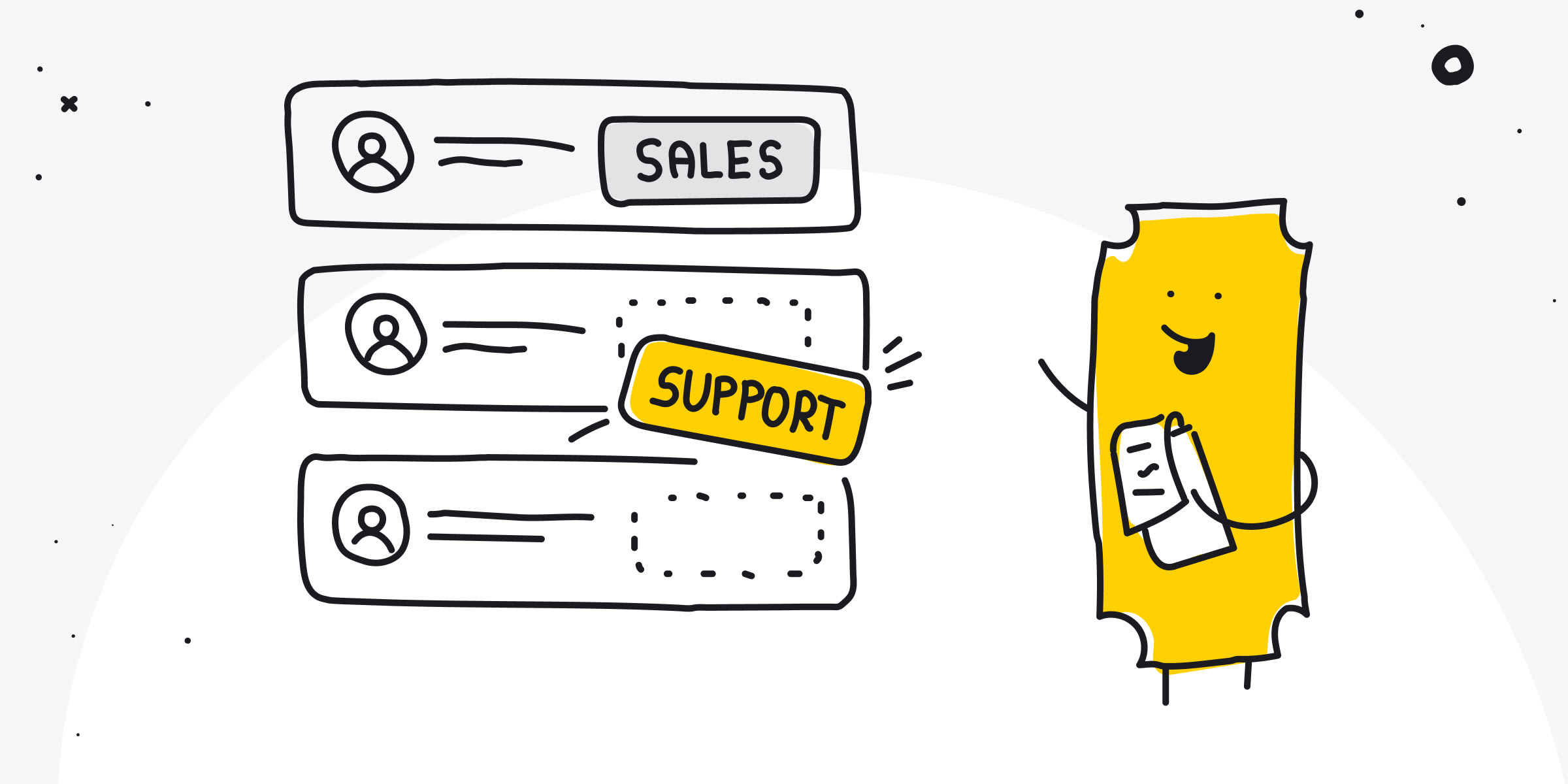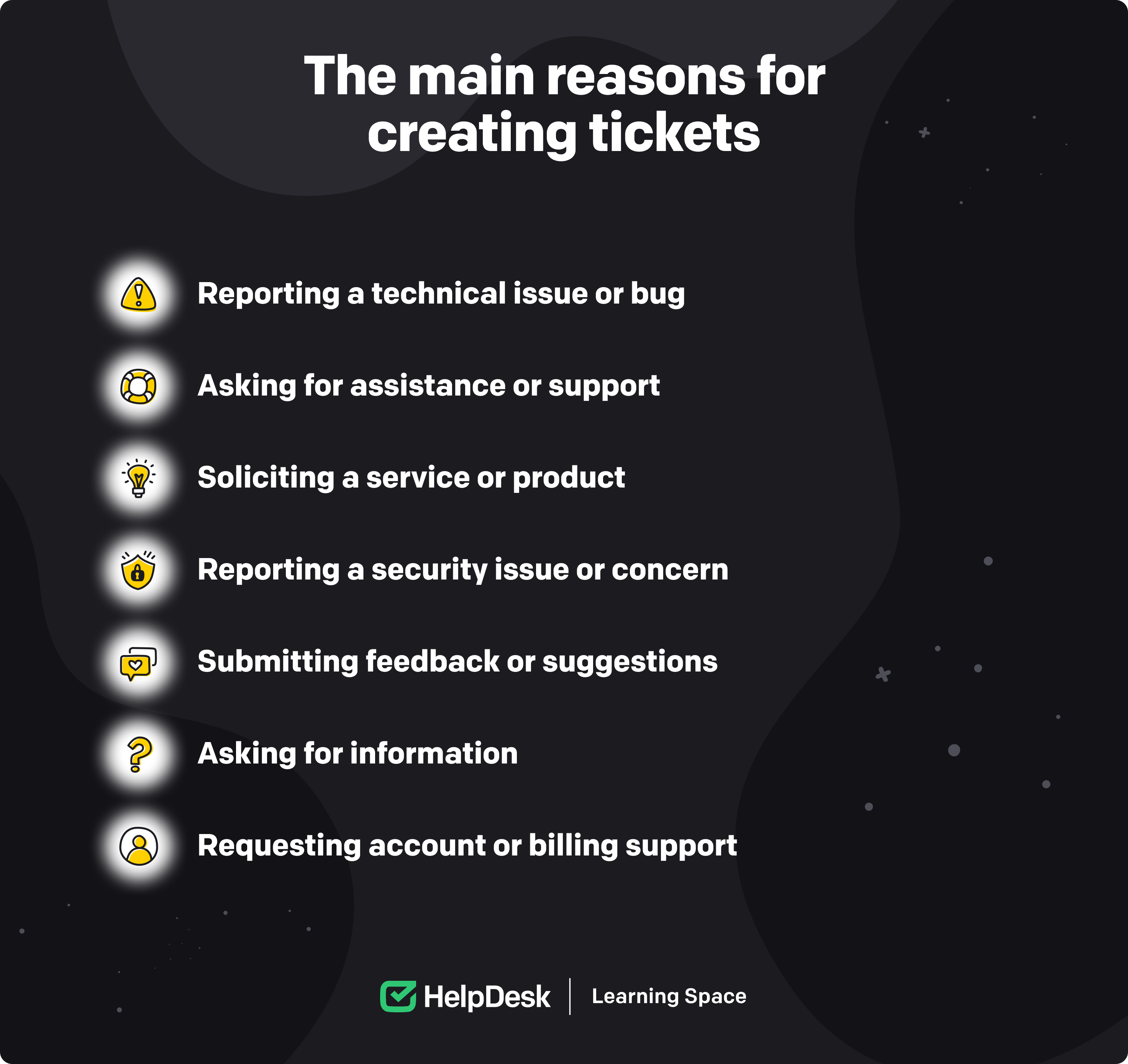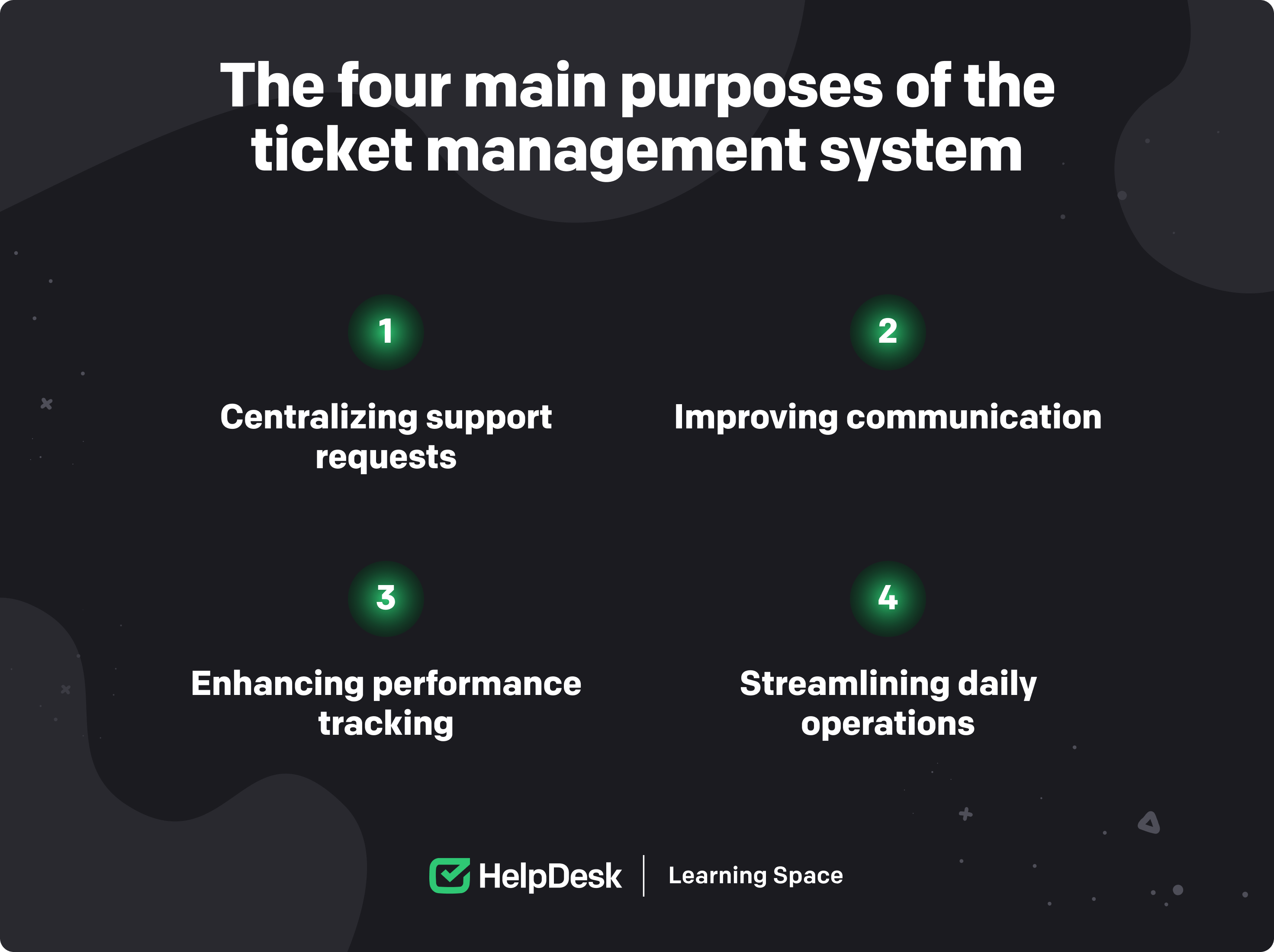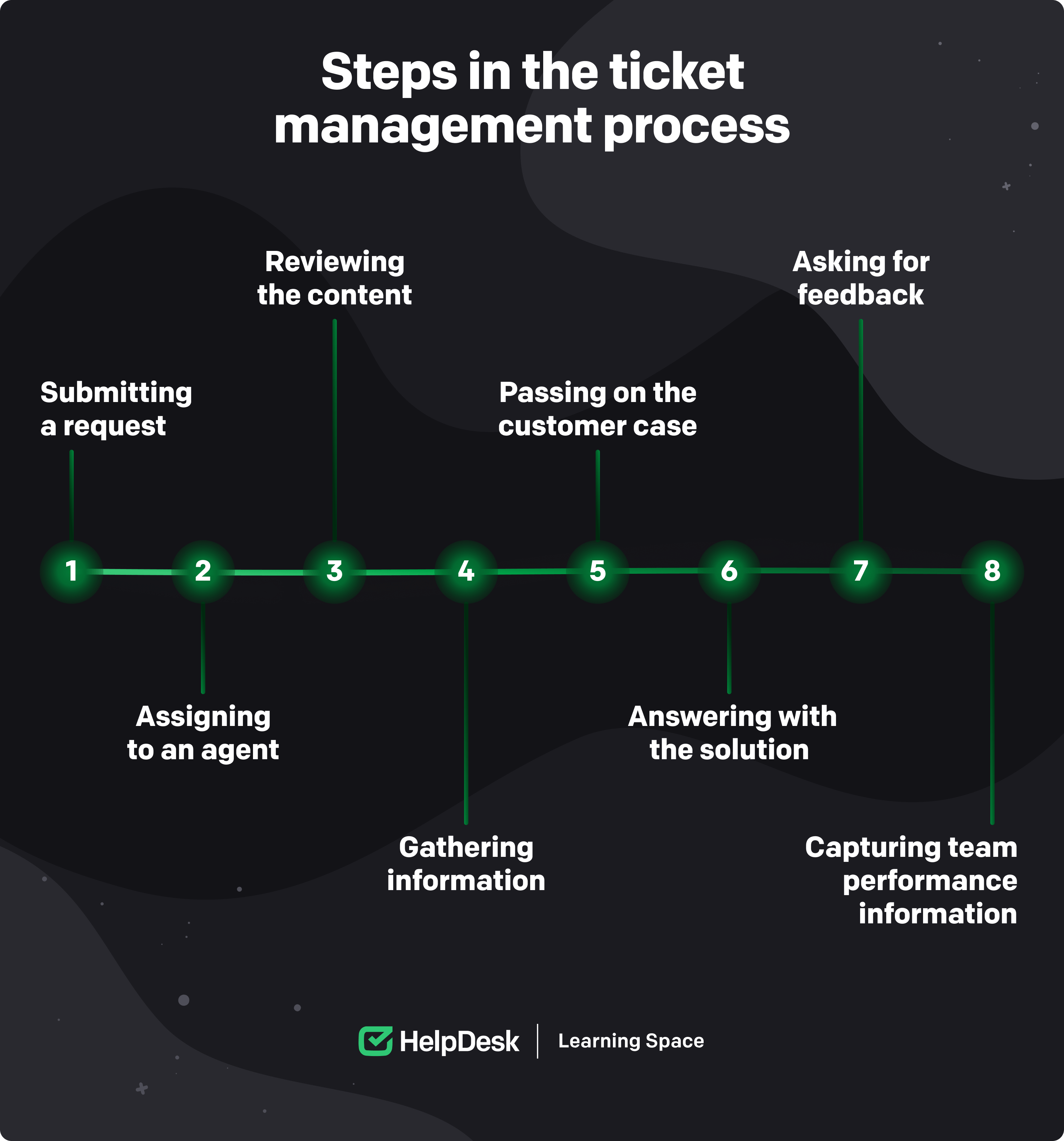


Busy supporting customers? Not anymore.
Watch hands-on webinar on workflows and easily automate your work in just five minutes!
We all experience a little pressure from time to time. But when it comes to working as a customer service agent, stress management can quickly become imposing. So how are you supposed to keep up with long wait times and huge piles of messages from recipients?
In this guide, I describe a ticket management process that, incorporated correctly, can give you the peace of mind you’re looking for in your day-to-day work. Learn why ticket management is your secret ingredient to acting smarter.

We all experience a little pressure from time to time. But when it comes to working as a customer service agent, stress management can quickly become imposing. So how are you supposed to keep up with long wait times and huge piles of messages from recipients?
In this guide, I describe a ticket management process that, incorporated correctly, can give you the peace of mind you’re looking for in your day-to-day work. Learn why ticket management is your secret ingredient to acting smarter.
The ticket management process is a flow designed to organize and manage tickets from their creation to resolution. It includes
Systematic tracking of tickets throughout their lifecycle.
Assigning responsible parties (agents and teams).
Improving communication and ensuring transparency in progress updates.
End-to-end ticket management not only provides solutions by identifying patterns and trends before more serious issues arise but also ensures that your customers are always informed of the status of their requests.
Additionally, tickets are used to gather detailed information. They help agents accurately diagnose cases by exchanging asynchronous messages to quickly find the root of the problem and the best solution. Ultimately, tickets give recipients clarity and insight into all customer service activities, providing a better customer experience.
Your customers may create tickets for a variety of reasons, depending on the type of service/product you offer. Some common reasons are:
End users may encounter a technical problem or software bug that needs to be resolved by a second-line support team or IT department.
Users may need help with your product or service, such as assistance using a feature or guidance on performing a specific task.
Your end users may want to request a new service or product, such as a new feature or an upgrade to an existing service. This can give you insight into customer demand that you can use for further research.
Users may report security issues, such as a data breach or a security vulnerability in your product or service.
Your end users may provide feedback or suggestions for improving your existing product or service, as well as remarks on your brand or teams’ operations.
Customers may need information about your product or service, such as pricing or availability.
Your users may need assistance regarding their accounts or billing issues, such as resetting passwords or resolving billing complaints.
 You need a service desk ticketing system to make your ticket management process a cinch. It makes it easy for any team member to access key customer data and previous tickets to know the background of the relationship and handle future support tickets efficiently.
You need a service desk ticketing system to make your ticket management process a cinch. It makes it easy for any team member to access key customer data and previous tickets to know the background of the relationship and handle future support tickets efficiently.
A ticket management system is a tool that helps businesses manage customer questions and support requests. It’s basically like a virtual inbox that keeps all customer messages from multiple touchpoints in one place and helps support teams respond to them quickly and efficiently.
With the ticket management system, customers can submit their requests through multiple channels like email, chat, website form, or even social media posts. These messages are then converted into manageable tickets that can be tracked and prioritized based on urgency and importance, allowing the customer service team to address the most pressing issues first.
Think of any help desk ticketing system as a way to stay on top of customer service without getting buried in a flood of emails or other messages. It’s a lifesaver for businesses that want to provide quality support while keeping everything organized and transparent. With this system, you can respond to customer questions more smoothly and efficiently by tracking, managing, prioritizing, and sorting them at one location.
There are many individual reasons why companies choose to have ticketing software in their support toolkit, and some of the most important are:
The centralization of customer requests. The ticket management software helps businesses collect, track, and manage all customer requests in one central location.
Efficient and organized workflows. Agents can use ticket management tools to streamline workflows by automating repetitive tasks, prioritizing tickets, and routing them to the appropriate team member for resolution.
Improved collaboration and communication. Ticket management systems allow teams to work together on tasks and communicate easily, ensuring everyone is on the same page.
Better customer experience. With ticket management solutions, agents can respond to customer requests quicker, provide personalized support, and keep customers updated.
Enhanced performance tracking. Businesses employ helpdesk ticketing systems to gain valuable insights into the performance of their operations by tracking support metrics such as response times, resolution rates, or customer satisfaction scores.
Consistent processes. By creating clear and consistent processes for handling requests, businesses can ensure that all customers receive the same level of support.
Greater visibility into customer interactions. By putting all requests under one roof, agents can gain better insight into interactions. They can also identify patterns and trends that will help them serve customers better.
Data-driven decision-making. Ticket management software provides managers with data-driven insights that can be used to optimize workflows, improve customer support, and make better business decisions.
Increased efficiency and productivity. Businesses can increase their efficiency and productivity by automating repetitive tasks and streamlining support workflows.
Business growth. By providing better customer care, optimizing actions, and using data-driven insights to make better business decisions, ticket management solutions help businesses to grow and succeed.
In short, ticket management tools are a game changer for those companies that want to improve customer support. They make it easier for employees to work together and keep customers in the loop with updates on their requests. By creating standardized workflows, businesses can ensure that all customers receive the same standard of care, resulting in higher satisfaction rates and a better overall experience.
One of the primary goals of a support ticket system is to centralize customer service requests in a single, easily accessible location. In this way, companies can effectively track, manage, and prioritize customer cases, ensuring that all of them are handled quickly.
In addition, desk ticketing systems provide valuable data and insight into customer service performance, enabling you to identify areas for improvement and streamline overall support operations.
In this section, I’ll delve into the key objectives of centralizing customer service requests with a ticket management system.
Centralizing all your support cases with the ticketing software is like putting all the puzzle pieces together, creating a clear picture of your customers’ needs. You’ll have everything in one place, organized, and easily managed.
With a globally centralized dashboard, you can quickly access all incoming messages and requests, making prioritization and governance a breeze. Also, you’ll be able to establish a standards-based process for handling customer-related matters, including automating the initial triage of support requests and routing them to the appropriate agent or team.
The desk ticketing system ensures timely responses, helping you to deliver exceptional customer service. By centralizing support requests, you can maintain a comprehensive record of interactions, including customer history, previous support requests, or the status of ongoing queries. This creates a valuable context that you can use to provide personalized care — you’ll be able to understand end users’ desires, anticipate their requirements, and ultimately provide them with the best possible experience.
Seamless and bright communication is a crucial element in providing excellent customer service. With help desk ticketing software, you can take your messaging game to the next level! The system acts like a “mind reader,” allowing you to anticipate your customer’s needs and provide them with the required support.
A robust service management platform helps businesses maintain consistent communication with their customers. Consistency in messaging is critical for building a solid brand image. By providing a centralized platform, managers can ensure that all support agents use the same tone and voice when communicating with customers, even if there are many of them on the team.
Using a service management system also enables your team to communicate with end users through a standardized channel, ensuring quick, consistent, and professional responses. Customers can submit requests through various sources, and the system will automatically assign them to the appropriate support agent or department based on predefined rules. This reduces the chances of customer queries being lost or overlooked.
Think of your desk ticketing software as a team coach. Tracking key metrics, such as response time and customer satisfaction, can provide valuable feedback on team performance and help identify areas for improvement. Well, it’s like having a game tape to review and learn from, but for your customer support.
With ticketing software, the team can easily access performance metrics, and managers can use these insights to guide them in improving support skills. On top of that, by analyzing these metrics over time, companies can make data-driven decisions to optimize support workflows and enhance customer satisfaction.
Help desk ticketing systems can also help businesses identify and address potential issues before they escalate. For example, suppose a particular support request consistently takes longer to resolve. In this case, you can easily investigate the original cause of the issue and take steps to optimize the process for that type of request.
If you’re running a business with dozens or even hundreds of customer messages every day, then you know how overwhelming it can be, to put it mildly. That’s where the ticketing software comes in.
With an IT support ticket system, you can automate repetitive tasks like routing, prioritization, and assignment of requests. These tasks can be time-consuming and prone to human mistakes, but with a ticket management system, businesses can automate them, freeing up support agents to focus on more complex and high-value tasks.
For instance, when a customer submits a question, the ticket management system can automatically direct it to the appropriate support agent or team based on predefined rules. These rules can take into account various factors like the customer’s history, the type of request, or your availability. This ensures that the most suitable specialist handles the customer’s query, improving the quality of assistance and reducing resolution times.
 By decluttering and automating support workflows, the help desk ticketing software can help you provide smooth sailing for your customers and improve the effectiveness of your operations.
By decluttering and automating support workflows, the help desk ticketing software can help you provide smooth sailing for your customers and improve the effectiveness of your operations.
Any ticket management process must be comprehensive, efficient, and tailor-made for each business case. But there are some general steps related to industry norms that you should follow in your desk ticketing system.
Customers should be able to submit a ticket through various channels, including email, phone, chat, or social media. The ticket contains essential information, such as the customer’s name, contact details, and the nature of the issue. Be approachable and let your recipients choose their favorite touchpoint.
Once a ticket is submitted, the support ticket system (for example, HelpDesk) automatically assigns it to an agent from a specific department. The agent’s expertise and workload should always be considered when assigning the case.
The agent reviews the ticket’s content to understand the customer’s issue and requirements, ensuring that they have all the necessary information to address the problem effectively.
Next, the agent investigates and collects more data to finally resolve the request. They answer any questions and meticulously update the ticket status details in the desk system. More importantly, customer service reps should document all interactions for other fellow agents so they can use the gathered knowledge to properly approach the end user and know what to do or avoid to keep them satisfied.
If the agent cannot resolve the ticket, they may escalate it to another team or expert to ensure the best possible outcome. The escalation process ensures that no issue is left unresolved and that the customer receives the necessary guidance.
The agent communicates with the customer, bringing a solution or at least addressing their concerns. This step may involve exchanging multiple messages to drive the resolution process.
When the customer is satisfied with the solution provided, the agent can close the ticket and ask for feedback on the support experience. Feedback can then be used to improve the overall process.
Managers can use data from the ticket management system to evaluate the support team’s performance. Metrics such as ticket volume, response time, and resolution time can help identify areas of improvement or ensure the team is meeting service level agreements (SLAs).

Ah, managing tickets — the glamorous side of customer support! But in all seriousness, if you want to keep your customers happy, it’s important to prioritize tasks. You don’t want to waste time on less critical issues while urgent ones go unresolved.
Let’s talk about response times. When it comes to customer care, time is of the essence. If you’re taking ages to get back to your recipients, they won’t be thrilled. In fact, they might start thinking you’re pushing them aside in favor of other concerns. So, it’s crucial to keep track of response times and ensure you provide timely and consistent support. One way to do this is by setting clear SLAs. This helps you manage expectations and ensure your customers get the guidance they need.
Another thing that can be helpful is using automation rules to streamline your workflows. For example, you might use automation to assign tickets to the right team member automatically or to escalate tickets that haven’t been resolved in a certain amount of time.
It’s also important to document your processes and ticket information. This helps ensure that communication channels are clear and consistent and that all team members have access to the data they need to resolve cases on the fly.
And, of course, you want to ensure your team is happy and healthy! Customer service reps can experience high levels of stress and burnout, so it’s essential to provide them with regular breaks. This can help improve employee satisfaction and reduce turnover, which ultimately benefits your customers as well.
Now let’s review an action-based list of guidelines below so you can always have it at hand and be sure that your ticketing process is top-notch:
Take an organized approach to managing support tickets. Prioritize tasks and respond in a timely manner.
Provide clear communication with customers when dealing with their requests. Be courteous and professional at all times (yes, even if your nerves start to fray). You can also invest in having a dedicated self-service portal where people can browse their customer issues.
Follow up regularly and provide feedback on the customer request progress. Ensure they’re kept updated on any status changes or delays that may occur along the way.
Use automated systems wherever possible to streamline ticket responses and reduce response time. Use canned responses, automated workflows, or other tools that take the burden of manual work off your shoulders.
Analyze common customer issues that arise over time to develop strategies for preemptive resolution and create more efficient processes as you advance.
Monitor comment logs attached to each ticket item to avoid missing critical notes about potential issues or delays while resolving them.
Gather feedback from customers whenever you can. This will help build trust between your organization and customers while providing valuable insights.
This organizational approach to ticketing helps streamline communication between you and your end users, leading to increased customer satisfaction and long-term loyalty. Always keep these steps in mind to make sure your customer service agents are providing top-notch service!
Ticketing software is the key to smooth task order management, and it doesn’t matter if you’re just starting out or have been handling cases for a while — having this solution at your fingertips is sure to streamline your support hub operations and save you time.
Focus on resolving issues quickly, keep your internal process consistent, and empower every customer support team member. Browse through the available best desk ticketing system options. Still, if you want to tackle tickets without obligation, you can always take advantage of HelpDesk’s free 14-day trial to see if such a customer service solution is for you.
HelpDesk can become your go-to tool to bring ticket management into your organization, allowing you to regain control of your ever-changing workload. From analyzing where the bottlenecks are to getting a bird’s eye view of your support tickets, integrating HelpDesk into your operations can give you back hours of effective time that would otherwise be missed.
So go ahead and install HelpDesk now for free. Join the rest of the support experts who fully embraced ticket management and go from chaos to complete control.
Weronika Masternak
Weronika is a product content designer at HelpDesk. She has a deep passion for telling stories to educate and engage her audience. In her free time, she goes mountain hiking, practices yoga, and reads books related to guerrilla marketing, branding, and sociology.
Try HelpDesk for free
For quick and intuitive tickets management